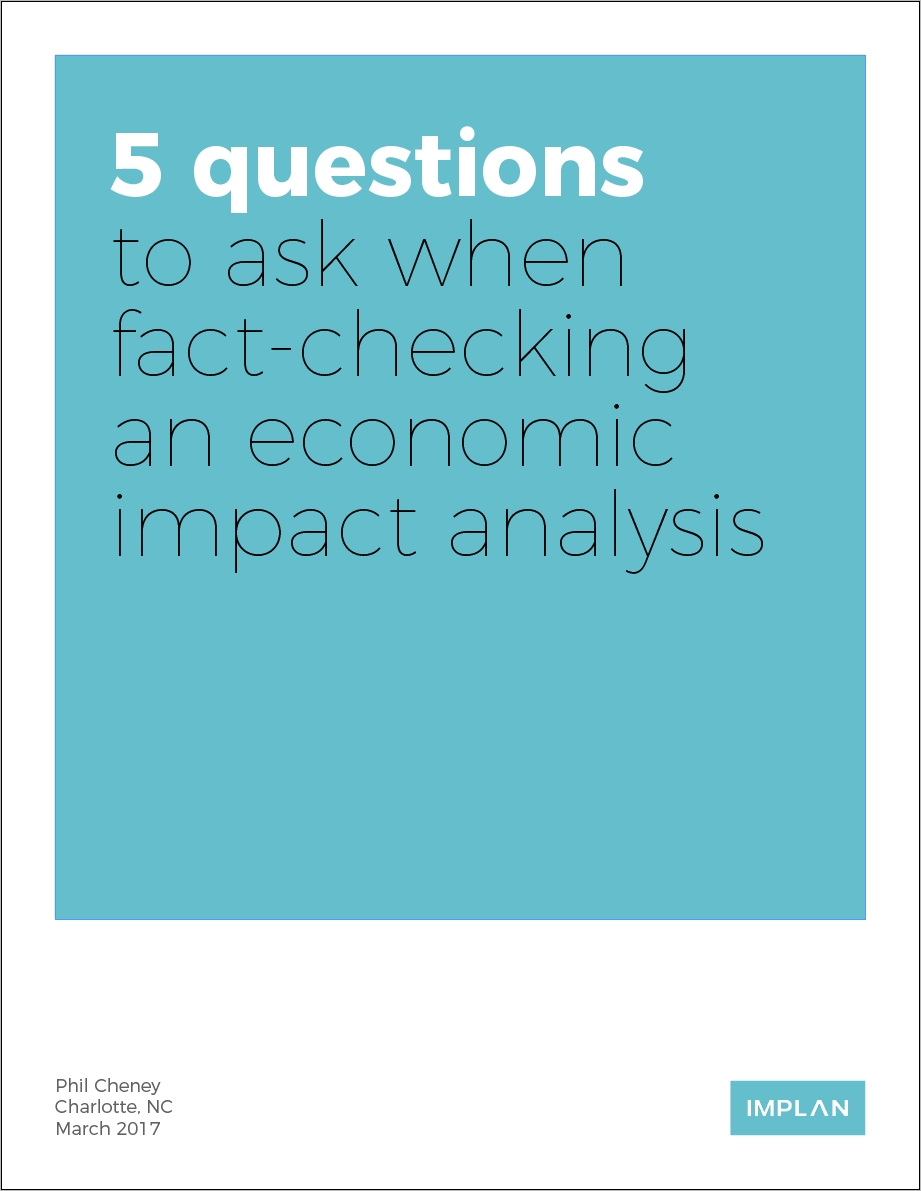Taxes and tariffs have resurfaced in the last few months and are at the forefront of the nation’s attention. Rumors of trade wars and threats of economic sanctions fly around the globe faster than Garfield can devour a lasagna. Historically, governments have used taxes and tariffs to stimulate or throttle markets to achieve a desired economic state of balance.
But in the last few decades since economies have become more globalized and data collection efforts have expanded and improved, more detailed economic data has become available and our understanding of how these economic and political tools affect the world has changed. If you’re interested in modeling or exploring how taxes or tariffs might affect your area or industry, then read on for our economists’ top-level advice and tips for modeling and communicating the effects of taxes and tariffs.
What you would need to know before building a model
When it comes to any economic impact analysis, the elephant in the room is that there’s no vacuum sealed bell jar in which to isolate and experiment with economic phenomena. It’s worthwhile, then, to include as many mitigations—however seemingly obvious—to lay the groundwork for the analysis. So let’s split the elephant into two categories:
 Many state, county, and city offices rely on a staff economist or economic modeling software to gauge the costs and benefits of tax incentive programs and the economic contributions of industries within their climes. If a study seems spurious to you, ask your local government offices about the study. Download "5 Questions to Ask When Fact-Checking an Economic Impact Analysis" to learn more.
Many state, county, and city offices rely on a staff economist or economic modeling software to gauge the costs and benefits of tax incentive programs and the economic contributions of industries within their climes. If a study seems spurious to you, ask your local government offices about the study. Download "5 Questions to Ask When Fact-Checking an Economic Impact Analysis" to learn more.1. Observed Market Behavior
Gathering as much historical evidence for how industries and markets respond to stimuli similar to what you’re trying to model can provide an informative gut-check for the results the model will provide as well as shape the nature of your inputs and other factors that should be taken into consideration as part of your analysis or report.
Beside making great historians, economists are ardent researchers. The myriad online resources and libraries of published studies may just have enough to help set a historical and academic context for the particular tax or industry you’re modeling. Rather than try to wrap our arms around that whole world of research, here’s a look at some of our favourite sources:
- The Economist’s Free Exchange blog: “Our economics correspondents consider the fluctuations in the world economy, in theory and practice.”
- CalculatedRISK: Bill McBride’s blog, named by Time Magazine as one of the top 25 financial blogs.
- Marginal Revolution: “In numerous reviews and ratings over the years Marginal Revolution has consistently been ranked as the best or one of the best economic blogs on the web, but it is more (and less) than that, also representing the quirks of its authors.”
- IMPLAN Help Desk: Solid instruction from the economics community concerning economic theory and modeling best practices for a wide array of analyses.
- Economics E-Journal: “Meant to encourage constructive interactions among a variety of international forums, including the G20, UN, the WTO, the ILO, the WHO, the World Bank, the IMF and other organizations.”
- EconomiA: “The aim of EconomiA is to contribute to the development of the science of economics and its applications, as well as to improve communication between academic researchers, teachers and policy makers.”
- Economies: An international, scholarly, peer-reviewed, open access journal of development economics and macroeconomics, published quarterly online by MDPI.
- Review of Economic Analysis: An open access, peer reviewed economic journal committed to open exchange of ideas and information without submission or publication fees.
- Regional Science Association: Great source for scholarly publications from authors from around the world.
- Economic Development Quarterly: Promoting "research supporting the formulation of evidence-based economic development and workforce development policy, programs, and practice in the U.S."
2. Assumptions
Whether inherent in the model or made by the researcher, all assumptions ought to make appearances in the methodology section of your study. For taxes and tariffs, one of the safest things to assume is a cost increase rather than a change in production technology (this is specific to a tax increase, as opposed to a tax cut).
For example, let’s assume it’s a final good, like cars, on which we want to model the effect of a price increase due to a tax or tariff. The simplest way to model this would be to run a negative household spending pattern under the assumption that consumers will still buy the cars, but therefore will have less money to spend on other things. The weakness with this approach, however, is that consumers may forego the purchase of a new car and instead spend more on vehicle repair and maintenance, or purchase a brand or model not subject to the tax. While households could drain down savings or use a loan to cover the higher cost, we’re assuming here that such measure would cause the household to reduce expenditures sometime in the future; in other words, such measures are merely postponing the necessary reductions in expenditures.
If we know that the tax or tariff is applied to an intermediate good like aluminum (rather than cars), the simplest method would be to run the analysis as a negative industry change in the industry or industries that purchase the commodity. However, some research into historical business practices for the industry might show that businesses can eat the cost, cut back on labor or planned investments in machinery, or switch to alternative inputs. Each of these can be modeled using specific techniques, but the set of assumptions you make about industry behavior can drastically affect the results of the analysis.
Which model to use?
I-Os or CGEs should be used as tools, not an end in themselves or as black boxes providing the answers (Community Economics, page 303). No matter which model you use, the results will only ever be as good as the assumptions and inputs which you bring to the table.
Input-Output (I-O)
- Works best for short-term impacts—Mainly because the model is static and based on descriptive data. Therefore, I-O won’t account for fundamental changes in an economy's structure that may occur as a result of the change being modeled. Generally, barring any catastrophic or unpredictable changes, we recommend keeping predictions within 5 years of the start date of the initial impact.
- Will not estimate any change in demand that will occur due to a price increase.
- Will not estimate how much of the tariff cost will be absorbed by the producers by way of decreased profits vs. passed on to the purchasers of the commodity in the form of a price increase.
- Model calculations are transparent and spending patterns are often editable.
Computable General Equilibrium (CGE)
- Works best for long-term impacts—This is because it takes into account substitution possibilities in terms of labor, capital intensive technology, circular flow of income across HH’s and firms (Community Economics, great example on page 304)
- Producers are assumed to be profit maximizers—producers will choose quantities of both inputs and output, given input and product prices and and subject to technological feasibility (in other words, producers are assumed to maximize efficiency above all else).
- Households are assumed to maximize utility—choosing consumption levels based on income and pricing
- Time-consuming, costly, and requires a high level of expertise to build and understand the workings of a model.
- Easy to hide assumptions and changes in model—many CGE models are black box.
One significant caveat if you’re looking for a tie-breaker between CGE and I-O is that I-O has wider sectorial detail. Community Economics, again, explains it thus:
Most CGEs, on the other hand, have only a small number of sectors, such as agriculture, durable and nondurable manufacturing, trade, services, and maybe government [compared to IMPLAN’s 536 sectors, 9 household income types, and 5 government levels]. CGE models that tend to have more than just the basic sectors can become computationally complex in very short order. Remember that the CGE must be able to replicate the benchmark data as well as provide reasonable simulations. Because most CGE models work with only a handful of sectors, to keep the model tractable they tend to be subject to aggregation bias. One of the central purposes of building regional models is to explore how different sectors of the economy respond to shocks or policy changes. Clearly different sectors will respond differently, sometimes significantly different. Aggregation bias is the treatment of dissimilar sectors as being the same.
Methodological concerns and presenting results
There’s a natural but tricky inflection point between presenting your results and trying to help the uninitiated or lay person understand the scope of the problem. Here are a few things that the best studies use to help all interested parties grasp the nature of your results:
- Report results as a range rather than a single number. This helps many audiences appreciate that the economic benefit or cost described in an impact analysis is ultimately an estimate whereas a final, fixed figure is often perceived as a promised result. A range could be as simple as a high-low estimate or as complex as setting up a series of scenarios which account for possible extremes within your assumptions (See the Louisiana Coastal Land Loss study, for example).
- Try to account for positive and negative effects (or opportunity costs). Example, if US steel producers turn to US aluminum producers to avoid the tax, this will incur higher costs for the steel producers (negative impact) but a boon to U.S. aluminum manufacturers (positive).
- Measure the existing contribution of the impacted industries. This sets a clear context for the results and helps audiences appreciate what’s at stake when policies might affect the trade flows for any single commodity or set of commodities (IMPLAN is great for this, has all the data and detailed instructions for conducting an industry contribution analysis).
- Consider % of GDP to determine if an impact or contribution is “big” or “small.” Including this number in the executive summary, or referring to it throughout a report, provides context for the results numbers as being a fraction of a whole. Keeping an eye on your geography’s GDP works well as a guestimate on whether your results numbers are accurate (if the economic contribution or impact is much larger than the local GDP, then something is very likely amiss—or you may be erroneously comparing output to GDP).
Wrapping it up
No matter the geography, industry, tax, or tariff, modeling the economic effects of a change in policy or anticipated market behavior is never cut-and-dry. However, armed with the clearest perspective on an issue, with enough information to make reasonable assumptions, and with the right tools, you can help others understand or appreciate the shape of the issue rather than having to rely on first impressions or glittering generalities. Economic impact analysis can help us understand how taxes and tariffs might affect us—whether as a country as a whole or just in our own pockets.



.png?width=80&name=IMPLAN_Logo_Print-Vector_NEW%20(2).png) Copyright 2024
Copyright 2024